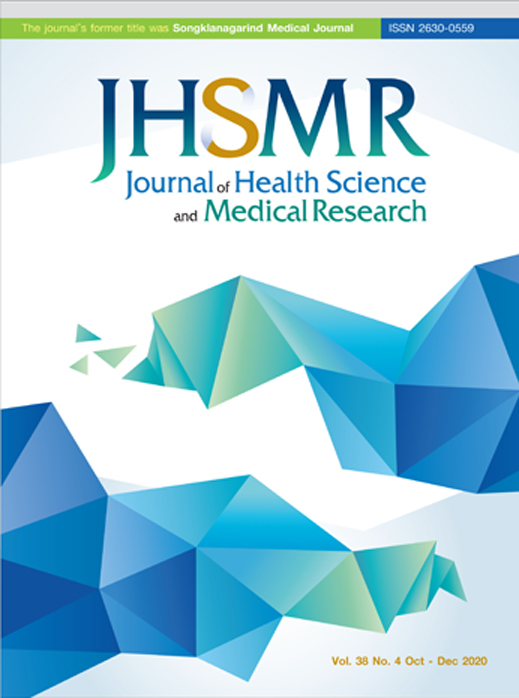Necessity of In-hospital Neurological Observation for Mild Traumatic Brain Injury Patients with Negative Computed Tomography Brain Scans
DOI:
https://doi.org/10.31584/jhsmr.2020746Keywords:
computed tomography brain scan, in-hospital neurological observation, mild traumatic brain injuryAbstract
Objective: The authors aimed to evaluate the necessity of in-hospital neurological observation for mild traumatic brain injury (TBI) patients, who did not have any evidence of intracranial injury from initial computed tomography (CT) brain scans.
Material and Methods: We retrospectively reviewed mild TBI patients with initial negative CT brain scans, receiving treatment at Songklanagarind hospital between January and December, 2018. All patients were observed in the emergency department short stay observation unit for 24 hours after injury. Patients’ medical records, initial and official CT brain scan interpretation were collected and analyzed.
Results: This study included 493 cases. No patient deteriorated from intracranial injury, while one patient deteriorated from hypoglycemia, associated with his underlying adrenal insufficiency. However, one patient was admitted to the in patient ward, due to a missed diagnosis of acute subdural hematoma from his initial CT interpretation. The incidence of missed intracranial injury from initial CT brain scan interpretation was 1.6%. The need for neurosurgical intervention (in-patient ward admission, anticonvulsant and repeat brain imaging) was 0.2% (1/493). No patient required surgical intervention.
Conclusion: Mild TBI patients, with initial negative CT brain scans, have very low risk for deterioration or need of neurosurgical intervention. Patient's underlying major comorbidity may be considered as an indication for in-hospital observation.
References
Wintermark M, Sanelli PC, Anzai Y, Tsiouris AJ, Whitlow CT, Imaging evidence and recommendations for traumatic brain injury: conventional neuroimaging techniques. J Am Coll Radiol 2015;12:e1-14.
Borg J, Holm L, Cassidy JD, Peloso PM, Carroll LJ, von Holst H, et al. Diagnostic procedures in mild traumatic brain injury: results of the WHO collaborating centre task force on mild traumatic brain injury. J Rehabil Med 2004;43(Suppl): S61–75.
Menditto VG, Lucci M, Polonara S, Pomponio G, Gabrielli A. Management of minor head injury in patients receiving oral anticoagulant therapy: a prospective study of a 24-hour observation protocol. Ann Emerg Med 2012;59:451–5.
Nagy KK, Joseph KT, Krosner SM, Roberts RR, Leslie CL, Dufty K, et al. The utility of head computed tomography after minimal head injury. J Trauma Inj Infect Crit Care 1999;46:268– 70.
Livingston DH, Lavery RF, Passannante MR, Skurnick JH, Baker S, Fabian TC, et al. Emergency department discharge of patients with a negative cranial computed tomography scan after minimal head injury. Ann Surg 2000;232:7.
Hartwell JL, Spalding MC, Fletcher B, O’mara MS, Karas C. You cannot go home: routine concussion evaluation is not enough. Am Surg 2015;81:395-403.
Schoonman GG, Bakker DP, Jellema K. Low risk of late intracranial complications in mild traumatic brain injury patients using oral anticoagulation after an initial normal brain computed tomography scan: education instead of hospitalization. Eur J Neurol 2014;21:1021–5.
Nishijima DK, Offerman SR, Ballard DW, Vinson DR, Chettipally UK, Rauchwerger AS, et al. Immediate and delayed traumatic intracranial hemorrhage in patients with head trauma and pre-injury warfarin or clopidogrel use. Ann Emerg Med 2012; 59:460-8.e7.
Kaen A, Jimenez-Roldan L, Arrese I, Delgado MA, Lopez PG, Alday R, et al. The value of sequential computed tomography scanning in anticoagulated patients suffering from minor head injury. J Trauma Inj Infect Crit Care 2009;68:895-8.
af Geijerstam JL, Oredsson S, Britton M. Medical outcome after immediate computed tomography or admission for observation in patients with mild head injury: randomised controlled trial. BMJ 2006;333:465.
de Boussard CN, Bellocco R, af Geijerstam JL, Borg J, Adami J. Delayed intracranial complications after concussion. J Trauma Inj Infect Crit Care 2006;61:577–81.
























